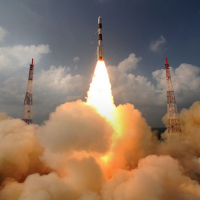India’s Spacecraft Nears Martian Atmosphere
 Mangalyaan was launched on Nov 5, 2013 from Sriharikota (photo: ISRO)
Mangalyaan was launched on Nov 5, 2013 from Sriharikota (photo: ISRO)
India’s landmark Mars mission is about to reach its destination, with the Mangalyaan (‘Journey to Mars’) spacecraft expected to enter the atmosphere of Mars in the next few days. On Monday, it will enter the sphere of influence of Mars, and scientists of the Indian Space Research Organization (ISRO) will begin 'waking' up its liquid apogee motor (LAM) that has been silent for nearly 300 days.
“The test firing on September 22 is like a trial. The dormant engine has to be brought back to live. It is a challenge but if one is prepared well for the exam, the confidence for success becomes higher," M. Annadurai, Programme Director, ISRO told Hindustan Times.
"The engine will be fired for nearly 4 seconds and almost half a kg of fuel will be needed for this operation," said Koteshwar Rao, ISRO’s scientific secretary. "We are confident that it will work. But just in case it does not, we have a Plan B which involves firing the eight thrusters. This however will entail a longer firing period and will need more fuel," he told the media.
India’s space agency launched the Mars Orbiter Mission (MOM) on November 5 last year to study the Martian atmosphere and sniff for evidence of methane. It was launched from ISRO’s spaceport at the Satish Dhawan Space Centre, Sriharikota, using the indigenous Polar Satellite Launch Vehicle (PSLV).
MOM was designed and developed by ISRO at a cost of just $69 million and marks India’s maiden foray into interplanetary flight. The country had earlier sent the Chandrayaan probe to the moon.
There are currently two international missions heading to Mars: Mangalyaan and NASA’s MAVEN (Mars Atmosphere and Volatile EvolutioN) orbiter.
MAVEN will reach the Martian orbit on Sunday, while Mangalyaan will be inserted into orbit on Wednesday. They will join the 3 current orbiters from USA and Europe, as well as NASA’s pair of surface rovers, Curiosity and Opportunity.
MAVEN's primary objective will be to explore Mars' upper atmosphere and its interaction with the solar wind. But it is unable to detect methane, which is why there is a lot of scientific interest in the Indian mission, since it is looking for methane, which could signal the evidence of life on Mars.
A S Kiran Kumar, associate director of ISRO Space Application Centre, that developed the methane sensor, told The Times of India that the spacecraft would pick up the methane absorption wavelength and measure the magnitude of methane up to the surface of the planet. “This method is different from that employed by Curiosity,” he said.
ISRO space engineers have been precisely navigating Mangalyaan during its long heliocentric trajectory from Earth to Mars through a series of inflight trajectory correction manoeuvres. The fourth and the final manoeuvre is scheduled on Monday.
The spacecraft is being monitored by the Indian Deep Space Network (IDSN) and NASA JPL’s Deep Space Network (DSN) to keep it on course. Mangalyaan will eventually be placed into an 377 km x 80,000 km elliptical orbit around Mars.
If all goes well, India will soon join an elite club of only four that have successfully investigated the Red Planet from its orbit or surface, including the Soviet Union, the United States and the European Space Agency (ESA).
- Karan Singh
To Learn More:
After 300 days of sleep, Mangalyaan engine will wake up tomorrow (by Vanita Srivastava, Hindustan Times)
World watches Mars Orbiter Mission’s quest for methane (by Chethan Kumar, The Times of India)
India gears up to put Mars mission in orbit (by Arun Ram, The Times of India)
India’s Maiden Mars Mission One Month out from Red Planet Arrival (by Ken Kremer)
- Top Stories
- Controversies
- Where is the Money Going?
- India and the World
- Appointments and Resignations
- Unusual News
- Latest News
- India College Chain’s Expansion into U.S. Draws Opposition from Massachusetts Officials over Quality of Education
- Milk Shortages in India Tied to Release of New Movies Featuring Nation’s Favorite Stars
- Confusion Swirls around Kashmir Newspaper Ban in Wake of Violent Street Protests
- Polio-Free for 5 Years, India Launches Vaccine Drive after Polio Strain Discovery
- New Aviation Policy Could Increase Service, Lower Ticket Prices






Comments